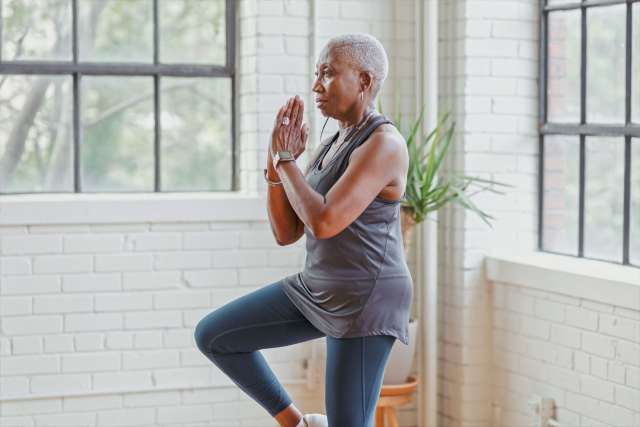Americans are increasingly dedicated to staying active as they age. However, a fall — or even the fear of falling — can quickly derail the best intentions to remain active.
This is not an unwarranted concern. Each year, one-in-three people age 65 and older fall, and that risk increases with age. According to the National Institute on Aging, about one-in-10 falls leads to serious injury, or worse. Falls are the single largest cause of death among older Americans.
Seniors can take measures to improve balance, prevent falls and stay active and functional.
“Falls can lead to a fracture or other significant injuries that further limit mobility,” says Lynn Matsuzaki, a physical therapist at UCLA Outpatient Rehabilitation Services in Santa Monica. “Age-related changes can contribute to balance issues, including decreased reaction time, decreased strength, diminished vision and ability to correct for being off-balance.”

Balance problems can begin in the 60s, especially among sedentary adults. Some older adults may start to notice that their balance isn’t what it used to be, and certain activities have become more difficult. “Patients may physicians to discuss need for assistive devices and/or factors affecting patient participation in therapy. “We set goals,” Matsuzaki says. “We use functional outcome measures and conduct specific balance tests to establish baseline numbers, so, when we reassess them, hopefully those numbers have improved. More importantly, patients provide input on their progress and how they’re responding to therapy.” The department also offers a virtual, community exercise class taught by physical and occupational therapists called SAIL, which stands for Staying Active and Independent for Life. “A portion of this class focuses on balance, while the remaining time includes upper/lower GERIATRIC MEDICINE For more information about UCLA Rehabilitation Services, go to uclahealth.org/rehab report they are not as confident walking on uneven surfaces, like grass, and avoid these varied terrains,” Matsuzaki says. This could be an indication that balance is declining.
It may be a mistake to simply write off balance problems as a natural part of aging. Seniors can take measures to improve balance, prevent falls and stay active and functional, Matsuzaki says. According to the National Institute on Aging, fall prevention includes monitoring factors like medications that can cause side effects of dizziness or fatigue. Fall prevention also includes addressing the home environment — adding good lighting, removing rugs or objects that can be trip hazards and wearing sturdy shoes.
At UCLA’s Outpatient Rehabilitation Services, with locations in Santa Monica and Westwood, physicians can refer patients for a balance assessment and fall-prevention education. Patient evaluations typically include walking and balance tests. Therapists are able to identify impairments and can often suggest corrective measures during that session, Matsuzaki says. “We want patients to start learning how they can be safer. We educate patients and develop a program of exercises for them to follow at home,” she says. “A good portion of these exercises involve strengthening the lower extremities.”
This service can help patients learn to safely navigate their environments by assessing age related changes affecting balance, coordination and strength, while taking into consideration other health issues that may impact their risk for falling. Therapists may communicate with physicians to discuss need for assistive devices and/or factors affecting patient participation in therapy.
Balance problems can begin in the 60s, especially among sedentary adults. Some older adults may start to notice that their balance isn’t what it used to be, and certain activities have become more difficult.
“We set goals,” Matsuzaki says. “We use functional outcome measures and conduct specific balance tests to establish baseline nu mbers, so, when we reassess t hem, hopefully those numbers have improved. More importantly, patients provide input on their progress and how they’re responding to therapy.”
The department also offers a virtual, community exercise class taught by physical and occupational therapists called SAIL, which stands for Staying Active and Independent for Life. “A portion of this class focuses on balance, while the remaining time includes upper/lower extremity strengthening and cardiovascular exercises,” Matsuzaki says. Participants must complete a fitness screen before joining the class. SAIL instructors are skilled in guiding participants to exercise at their own pace and intensity levels so they are safe and benefit from the class. Prevention is good medicine, she adds: “When someone is active, he or she is maintaining strength and challenging their balance system.”
